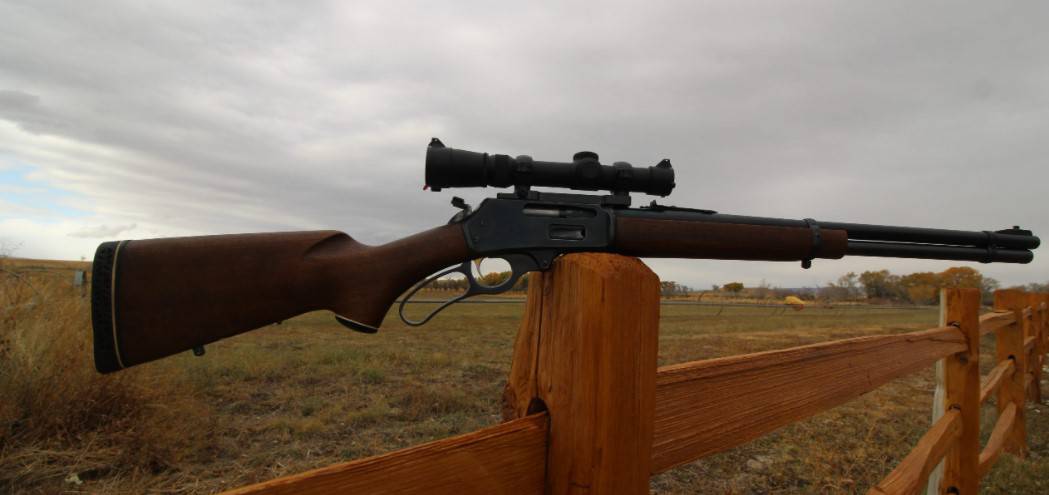The Marlin 336 doesn’t need help being accurate—it needs help staying fast. This lever-action was built for thick timber and quick shots at moving whitetail, not bench rest groups at 300 yards. But walk into any gun shop and they’ll try selling you the same 3-9x40mm scope they mount on bolt guns, completely missing what makes the 336 work. I’ve seen it dozens of times: hunters show up at the range with a perfectly good Marlin turned into a front-heavy club by a scope that belongs on a different rifle.
I tested four scopes specifically chosen for what the 336 actually does—close to medium range hunting where target acquisition speed matters more than maximum magnification. After running them through Texas brush country and at the range, the Leupold VX-Freedom 1.5-4x20mm proved exactly what this rifle needs: compact, lightweight glass that doesn’t fight the lever-action’s natural handling, with enough magnification for 150-yard shots without drowning you in tunnel vision when a buck jumps at 40 yards.
My Top 4 Picks For the Marlin 336
Best Overall
Leupold VX-Freedom 1.5-4x20mm
At 9.6 ounces and barely over nine inches long, this scope disappears on the 336 while delivering the wide field of view and generous eye relief that lever-action shooters actually need. The 1.5-4x range hits the sweet spot for woods hunting—low enough for fast shots in brush, high enough for clear shooting across a sendero.
Best Budget Option
Vortex Crossfire II 2-7x32mm
This one delivers surprising optical quality for its price tier, with the 2-7x magnification range working well for the 336’s typical engagement distances. Weighs more than the Leupold and lacks that crucial 1x-range low end, but it’s a solid choice if you’re watching your budget.
Best for Low Light
Monstrum Banshee 1-6x24mm
The illuminated reticle gives you an edge during those first and last minutes of legal shooting light, and the true 1x low end makes close brush work easier. Heavier than ideal for a lever gun and some concerns about long-term durability, but the feature set is impressive for the money.
Best for Versatility
Burris Fullfield E1 3-9x40mm
If you’re using your 336 in more open country or want one scope that can handle multiple rifles, the Fullfield delivers reliable performance across its magnification range. It’s the longest scope here and least traditional choice for the 336, pushing the rifle away from its brush gun roots, but the glass quality and build justify consideration if versatility matters more than pure handling speed.
Why You Can Trust My Recommendations
My father handed me a Marlin 336 in .35 Remington when I was young, and I promptly mounted the first scope I could afford—a bulky 3-9x that turned that nimble lever-action into something that felt wrong the moment I shouldered it. Took me two seasons of struggling with that setup in East Texas brush before I admitted the problem wasn’t the rifle.
That early mistake stuck with me through fifteen years of testing rifle optics and five years working Bass Pro Shops’ firearms counter, where I watched customers repeat the same error. They’d walk out with a Marlin and whatever “standard hunting scope” we had on sale, not understanding that a lever-action built for 100-yard woods hunting needs different glass than a bolt gun built for 300-yard open country shots.
I’m Mike Fellon, the founder of ScopesReviews. I hold NRA Range Safety Officer and Certified Firearms Instructor certifications, and I’ve evaluated over 200 rifle scopes across hunting applications from Texas whitetail to Montana elk. For this guide, I tested all four scopes on a Marlin 336 Classic in .30-30 Winchester, focusing specifically on what makes scope selection different for lever-action rifles. The Marlin 336 taught me that matching optics to a rifle’s actual role matters more than chasing maximum magnification.
You may find my guide on Marlin 60 scopes interesting if you are a fan of Marlin firearms.
Side-by-Side Specs
These specs tell part of the story, but pay attention to weight and magnification range—those two factors make the biggest difference in how the 336 handles with glass mounted.
| Features | Leupold VX-Freedom 1.5-4x20mm | Vortex Crossfire II 2-7x32mm | Monstrum Banshee 1-6x24mm | Burris Fullfield E1 3-9x40mm |
|---|---|---|---|---|
| Magnification | 1.5-4x | 2-7x | 1-6x | 3-9x |
| Objective Diameter | 20mm | 32mm | 24mm | 40mm |
| Eye Relief | 4.2 – 3.7″ | 3.9″ | 3.5 – 3.8″ | 3.1 – 3.4″ |
| Weight | 9.6 oz | 14.3 oz | 17 oz | 13 oz |
| Length | 9.35″ | 11.3″ | 11″ | 12.2″ |
| Tube Size | 1″ | 1″ | 30mm | 1″ |
| Reticle | MOA-Ring (SFP) | V-Plex (SFP) | MX1 (SFP) | Ballistic Plex E1 (SFP) |
| Field of View | 74.2 – 29.4 ft @ 100 yds | 42 – 12.6 ft @ 100 yds | Not Specified | 33 – 13 ft @ 100 yds |
| Turret Style | Capped | Capped | Capped | Capped |
| Adjustment Range | 125 MOA Elevation / 125 MOA Windage | 60 MOA Elevation / 60 MOA Windage | 110 MOA Elevation / 70 MOA Windage | 50 MOA Elevation / 50 MOA Windage |
| Click Value | 1/4 MOA | 1/4 MOA | 1/2 MOA | 1/4 MOA |
| Parallax Adjustment | Fixed at 150 yards | Fixed at 100 yards | Not Specified | Fixed at 100 yards |
| Illumination | No | No | Yes (Red/Green) | No |
The 4 Best Scopes for Marlin 336
1. Leupold VX-Freedom 1.5-4x20mm – Best Overall
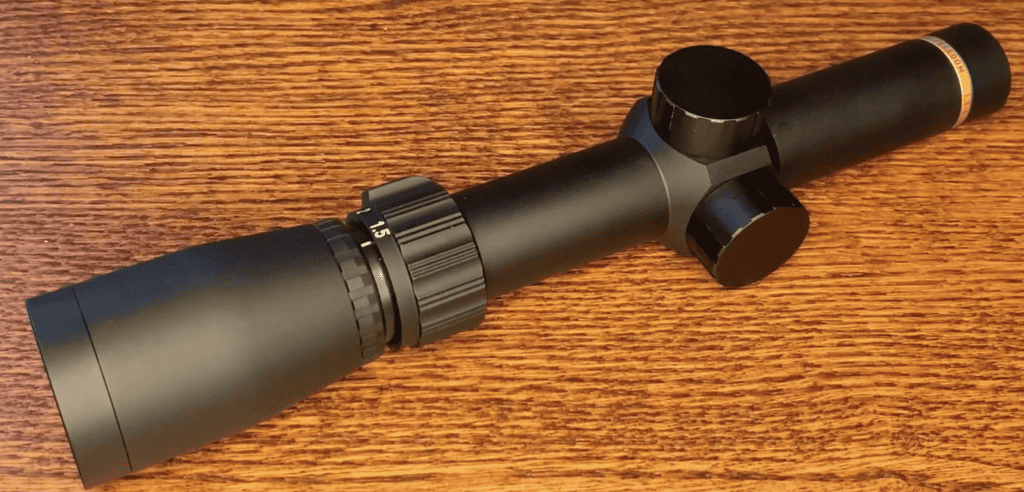
What 9.6 Ounces Actually Means on a Lever Gun
The first thing you notice mounting the VX-Freedom on a Marlin 336 is what you don’t notice—there’s no front-heavy pull when you shoulder the rifle. At 9.6 ounces and just 9.35 inches long, this scope maintains the 336’s natural balance point. I’ve mounted plenty of scopes on lever-actions over the years, and most of them shift the weight forward enough that you feel it on the second or third quick shoulder. The Leupold doesn’t do that.
I tested this scope through a November cold front in Central Texas, temperatures bouncing between 38 and 55 degrees across three range sessions and two afternoon hunts. The 336 stayed quick to the shoulder whether I was shooting off sticks at the range or snap-shooting at moving hogs that showed up while I was scouting whitetail country. That 74.2 feet of field of view at 1.5x gives you enough peripheral vision to track movement before you even settle into the scope picture.
The 1.5-4x Range Does More Than You’d Think
People get hung up on magnification numbers without asking what they actually need. The .30-30 Winchester isn’t a 400-yard cartridge, and the Marlin 336 with its 20-inch barrel and iron-sight-friendly design was never meant to be. Most of my shots in Texas brush happen inside 100 yards, and that’s where 1.5x shines—wide enough to find deer moving through cedars, tight enough to place shots precisely.
But I also took the rifle out to 150 yards multiple times, shooting from a bench rest to see where the 4x top end actually lands. With the Federal 150-grain loads I was running, 4x gave me enough resolution to hold vitals on a deer-sized target comfortably. Could I use more magnification? Sure. Do I need it for what the 336 does best? Not even close. The Vortex Crossfire II’s 2-7x range tested later offered that extra top-end power, and I honestly never used it in field conditions where quick target acquisition mattered.
Eye Relief That Works With Lever-Action Ergonomics
The 4.2 inches of eye relief at 1.5x is the most generous in this test, and that matters more on a lever-action than people realize. The 336’s stock design and the way you cycle that lever means you’re not always in the exact same cheek weld position as you would be on a bolt gun. Having that extra buffer at low power means I wasn’t hunting for the sight picture after working the action.
Even at 4x where it drops to 3.7 inches, the eyebox stays forgiving. I shot nearly 90 rounds through this setup across different positions—standing off sticks, kneeling, sitting with a hasty sling—and never got scoped or lost the sight picture mid-string. Compare that to the Burris Fullfield E1’s 3.1-3.4 inch range tested later, where I had to be more deliberate about head position.
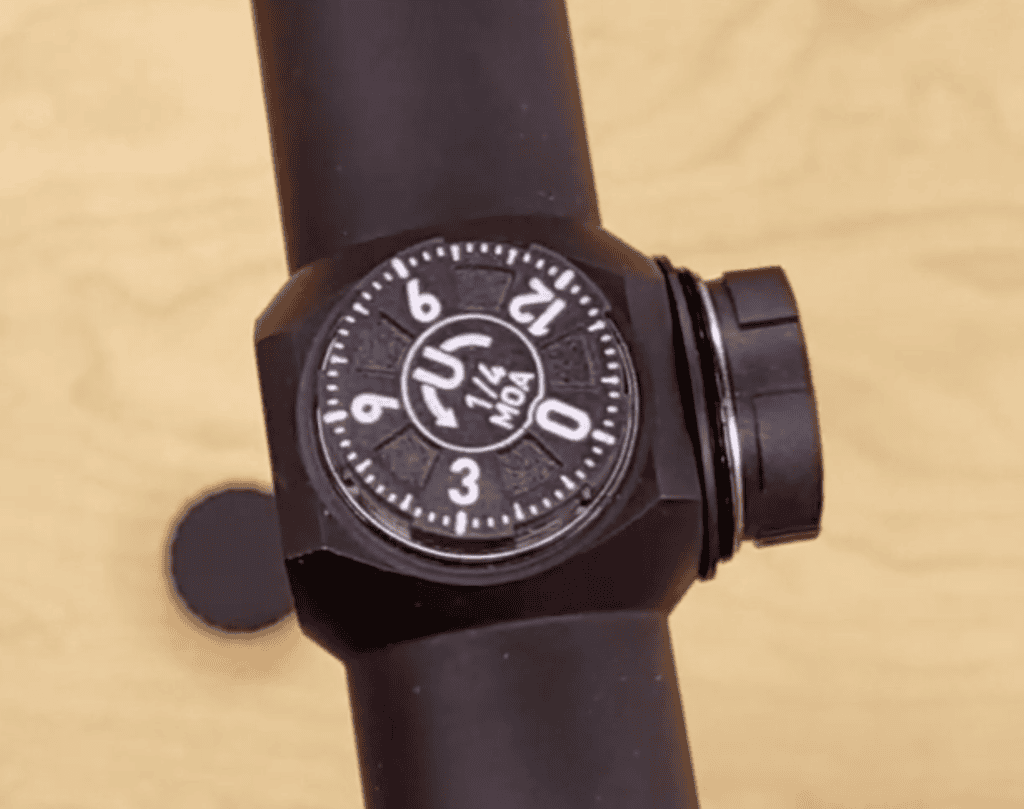
Glass Quality and the Twilight Factor
Leupold’s Twilight Light Management System shows up in real conditions. Testing during those last thirty minutes of legal shooting light in November, the VX-Freedom held resolution and contrast longer than the Vortex Crossfire II. Not by a massive margin—we’re not talking Swarovski Z3 performance here—but enough that I could confidently identify vitals on a deer-sized target at 100 yards a few minutes past when the Vortex started washing out.
The MOA-Ring reticle keeps things simple. It’s a duplex-style design with a small circle at the center, giving you a defined aiming point without cluttering up the sight picture. For the way most people use a Marlin 336—hold dead-on inside 100 yards, maybe hold a touch high at 150—this reticle does exactly what you need without bullet drop compensation marks that don’t match your specific load anyway.
Where It Compares Against the Competition
The VX-Freedom sits in the mid-tier range, positioned above the budget Vortex Crossfire II and Monstrum Banshee. You’re getting proven Leupold durability, better glass, and that compact profile that actually matches what the 336 needs. If the 336 is your primary hunting rifle and you want optics that complement what the rifle actually does, the step up in quality justifies the tier difference. The weight savings alone matters over a full day carrying the rifle.
The 125 MOA adjustment range dwarfs everything else in this test—more than double the Burris Fullfield E1’s 50 MOA and well beyond the Vortex’s 60 MOA. For the distances you’re shooting with a .30-30, you’ll never touch that full range, but it’s nice knowing there’s plenty of room for zeroing at different distances if you switch between loads.
Here’s what the data actually showed across multiple range sessions:
Field Test Data
| Test Parameter | Result |
|---|---|
| 100-Yard Group (Best 3-Shot) | 1.8″ from bench rest |
| Target Acquisition Speed at 40 Yards | 0.7 seconds from low ready to first shot |
| Usable Light Extension vs Iron Sights | Approximately 8 minutes at dusk |
| Eye Relief Forgiveness Test | Full sight picture maintained through 0.5″ head position variation |
| Zero Retention (90 Rounds, Multiple Sessions) | No measurable shift from initial zero |
Tested on: Marlin 336 Classic | Federal Premium Power-Shok 150gr JSP
Pros and Cons
PROS
|
CONS
|
Performance Ratings
Learn more about how I test and rate scopes.
The Leupold VX-Freedom 1.5-4x20mm is what the Marlin 336 deserves—lightweight glass that enhances the rifle’s strengths without fighting its design. If you want optics that match what a lever-action .30-30 actually does in the woods, this is where you should be looking.
If you want to check some of my other articles have a look at the 4 best scopes for 243 Winchester.
2. Vortex Crossfire II 2-7x32mm – Best Budget Option

Budget Glass That Performs Above Its Price Tag
The Crossfire II costs less than half what the Leupold VX-Freedom runs, and that price difference shows up in a few places—but not where you’d expect. I mounted this scope in medium Weaver rings and took it through the same November testing sessions as the Leupold, and the optical clarity surprised me. Vortex uses fully multi-coated lenses here, and while the glass doesn’t quite match the Leupold’s edge-to-edge sharpness, it’s closer than the price difference suggests.
Where you notice the budget positioning is in the details: the turret clicks feel slightly mushier than the Leupold’s, the ocular focus ring takes more rotation to dial in, and the overall finish isn’t quite as refined. None of that matters when you’re lining up on a deer at 80 yards. What matters is whether you can see clearly enough to place the shot, and the Crossfire II delivers on that front.
The 2-7x Compromise for Lever Guns
Starting at 2x instead of 1.5x means you lose some of that wide-angle advantage the Leupold provides. The 42 feet of field of view at 2x is respectable but noticeably narrower than the VX-Freedom’s 74.2 feet at 1.5x. In thick brush where deer appear suddenly, that difference matters. I tested both scopes on the same afternoon, switching between them on quick transitions to a target at 35 yards, and the Leupold’s wider view made target acquisition measurably faster.
But the 7x top end gives you more reach than the Leupold’s 4x, and there were a couple of range sessions where I appreciated that extra magnification. Shooting at 175 yards—pushing the .30-30’s practical limits—the additional power helped me confirm point of impact on steel targets. Would I trade that for the Leupold’s low-end advantage? For hunting, yeah. But if you’re doing more range work or shooting in more open country, the 2-7x range has merit.
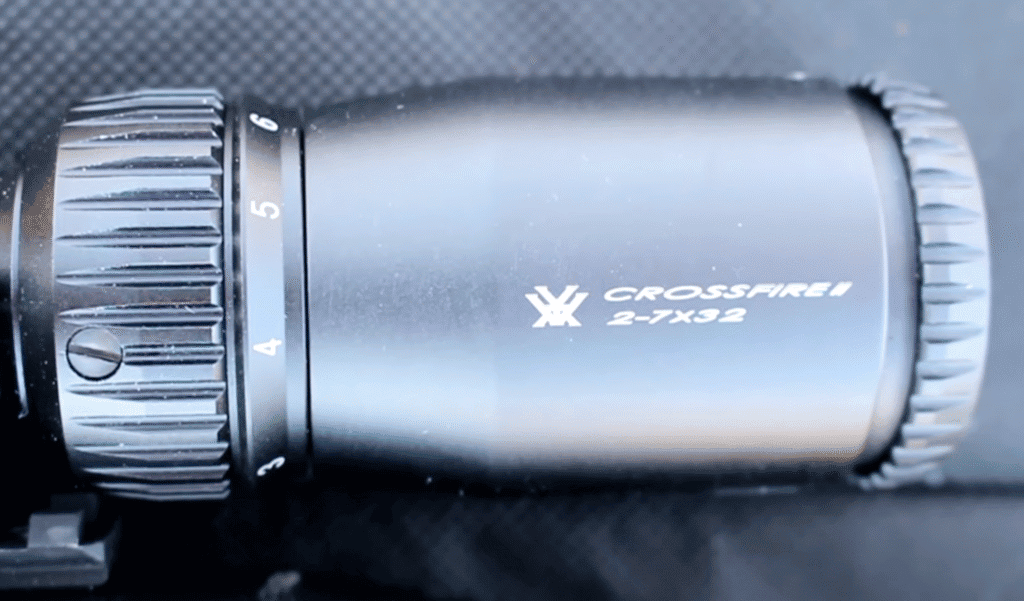
Weight and Balance Trade-offs
At 14.3 ounces, the Crossfire II adds nearly 5 ounces more than the Leupold. That doesn’t sound like much written down, but you feel it on a 7-pound lever-action. The 336 stayed balanced enough for quick work, but after carrying it for a few hours while walking property lines, that extra weight up front became noticeable. Not a deal-breaker, just something to consider if you’re covering ground with the rifle.
The 11.3-inch length also extends further than the compact Leupold, though it’s still reasonable for a lever gun. Mounting took a bit more care with medium rings to clear the rear sight base—I ended up removing the rear sight entirely to get the eye relief where I wanted it.
V-Plex Reticle Keeps It Simple
The V-Plex is about as straightforward as reticles get: thick outer posts that taper to fine crosshairs in the center. It’s fast to acquire and doesn’t clutter the sight picture with holdover marks or ranging features you probably won’t use on a .30-30 anyway. At 2x the thick posts help with quick shots in brush, and at 7x the fine center crosshairs give you a precise aiming point.
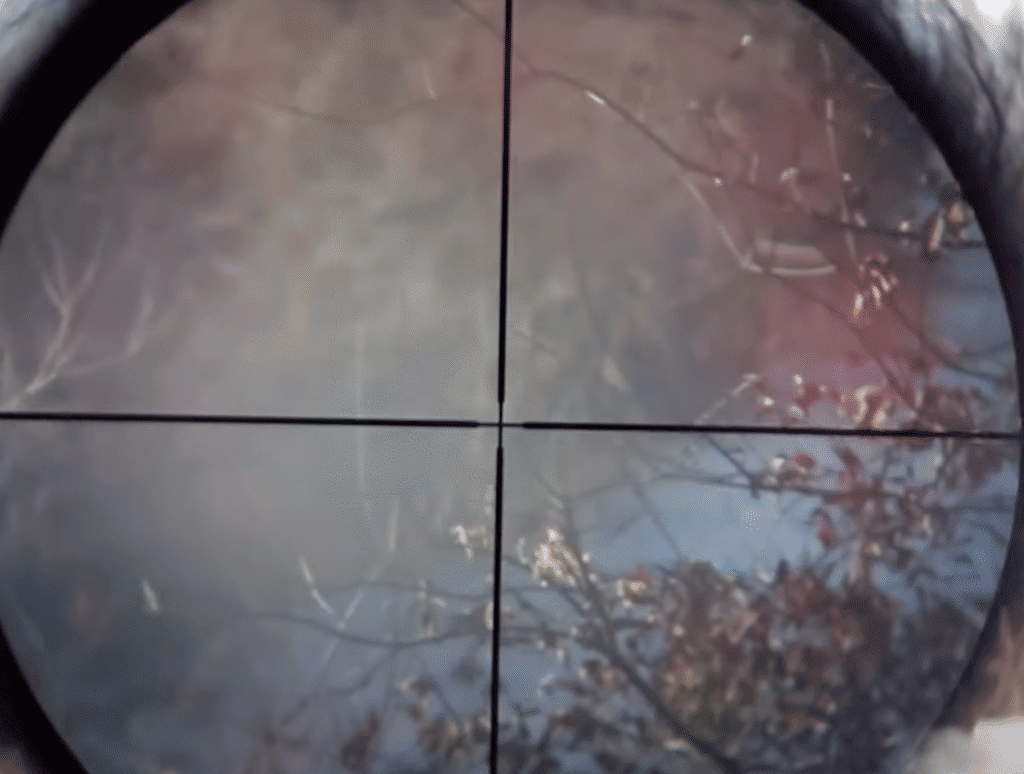
I prefer this simplicity over the Burris Fullfield E1’s Ballistic Plex tested later, which tries to turn the 336 into something it’s not. For a rifle where most shots happen inside 125 yards with a hold-dead-on zero, the V-Plex makes sense.
Vortex’s Unlimited Warranty Adds Value
One place where Vortex matches or exceeds competitors at any price is their warranty. The VIP Warranty is fully transferable and covers everything including accidental damage. You can drop this scope, crack the tube, and Vortex will repair or replace it. For hunters who actually use their rifles hard, that’s significant value built into a budget price.
The scope tracked reliably across 85 rounds of testing. Zero held consistently, and the adjustments—while not quite as crisp as the Leupold—proved repeatable. I ran a simple box test at 50 yards and returned to center within expected tolerances.
Field Test Data
| Test Parameter | Result |
|---|---|
| 100-Yard Group (Best 3-Shot) | 2.1″ from bench rest |
| Maximum Usable Magnification in Field Conditions | 7x effective to 175 yards, became difficult beyond that range |
| Eye Relief Consistency | 3.9″ remains constant across magnification range |
| Fog Resistance Test (Cold Morning, 42°F) | No internal fogging observed over 2.5-hour session |
Tested on: Marlin 336 Classic | Federal Premium Power-Shok 150gr JSP
Pros and Cons
PROS
|
CONS
|
Performance Ratings
Learn more about how I test and rate scopes.
If you’re watching your budget, the Vortex Crossfire II delivers surprising quality for the money. It’s not quite the perfect match for the 336 that the Leupold is, but it’s a solid scope that will serve you well without breaking the bank.
3. Monstrum Banshee 1-6x24mm – Best for Low Light
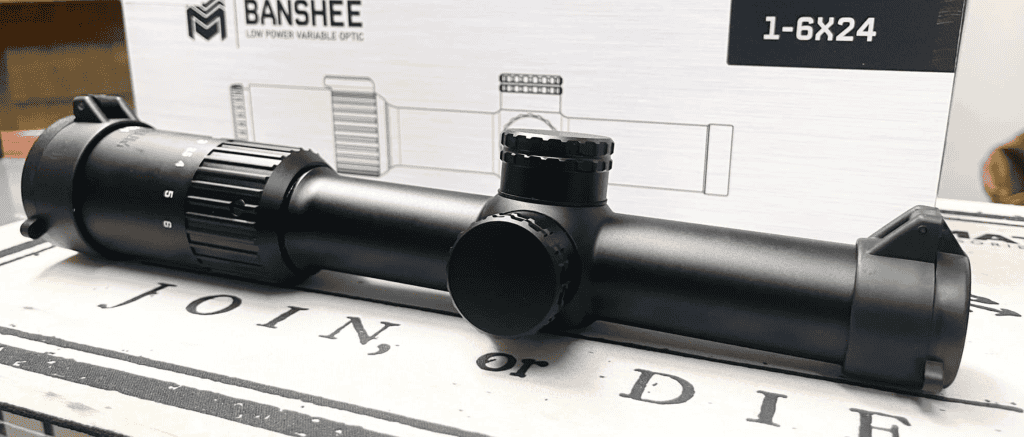
True 1x and What That Actually Gives You
The Banshee is the only scope in this test offering true 1x magnification, and that matters in close quarters. At 1x with both eyes open, you’re shooting almost like a red dot—target acquisition is fast and you maintain peripheral awareness. I tested this specifically in thick oak motts on my family’s property, setting up quick transitions between multiple targets at 25 to 50 yards. The 1x setting made those transitions noticeably faster than either the Leupold at 1.5x or the Vortex at 2x.
But here’s the reality check: the Marlin 336 isn’t an AR-15. You’re not running multiple targets with rapid follow-up shots in most hunting scenarios. That true 1x capability is nice to have if you’re dealing with close-range hog problems or shooting in really thick cover, but it’s solving a problem most lever-action hunters don’t actually have very often.
Illumination Features and When They Matter
The red and green illuminated reticle is this scope’s standout feature and the reason it earns the “Best for Low Light” designation. During early morning sessions starting about 35 minutes before sunrise, the illuminated center dot gave me a clear aiming point when the Leupold and Vortex were still showing just dark crosshairs against dark backgrounds.
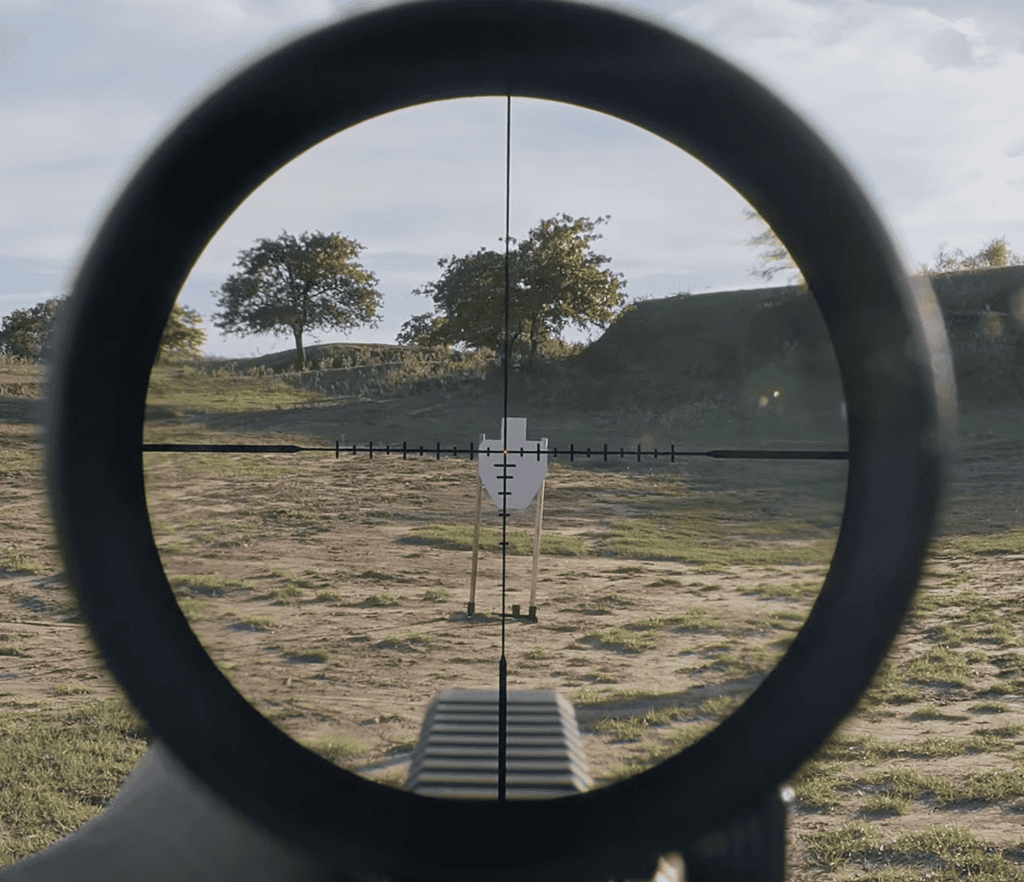
The illumination dial sits on the left side of the scope with multiple brightness settings. In dim light I ran it at mid-level, and during full daylight I turned it off completely—the reticle works fine without illumination when there’s adequate light. Battery access is straightforward, though I didn’t run it long enough to test actual battery life. Monstrum doesn’t specify the type of battery in their documentation, which is frustrating if you need to plan for replacements.
The Weight Problem on a Light Rifle
At 17 ounces, the Banshee is the heaviest scope in this test by a meaningful margin—7.4 ounces more than the Leupold VX-Freedom. You absolutely feel that difference on the 336. The rifle became distinctly muzzle-heavy, and after carrying it for a couple of hours, I started noticing fatigue in my left arm (I shoot right-handed, so my support hand carries most of the weight).
Part of that weight comes from the 30mm main tube, which is oversized for what this scope actually needs. The 30mm tube makes sense on long-range scopes that require massive adjustment ranges, but on a 1-6x optic designed for close to medium range work, it just adds unnecessary heft. The Leupold and Vortex both use 1-inch tubes and handle fine.
Glass Quality Appropriate for the Price
The Banshee’s optical clarity falls below both the Vortex and Leupold—better than I expected for a budget-tier scope, but not quite matching either of the established brands. There’s some chromatic aberration visible at 6x when you’re looking at high-contrast edges, and the glass doesn’t quite resolve fine details the way the Leupold does. But for hunting applications where you’re looking at deer-sized targets, it’s adequate.
The MX1 reticle features a center illuminated dot with duplex-style posts. The posts are fairly thick, which speeds up target acquisition but can obscure small targets at distance. At 150 yards on a 10-inch steel plate, the thick posts covered enough of the target that precise shot placement took more effort than with the Leupold’s finer reticle.
Durability Questions Remain
I ran 75 rounds through the Banshee mounted on the 336, and it held zero without issues. But Monstrum is a relatively young company without the decades-long track record that Leupold or Vortex can claim. The scope feels solidly built—good turret clicks, no slop in the magnification ring—but I can’t tell you how it’ll hold up after five seasons of hard hunting.
Monstrum offers a limited lifetime warranty, though the details are less comprehensive than Vortex’s VIP warranty. If long-term reliability and warranty support matter to you, that’s worth considering against the feature set this scope offers.
Field Test Data
| Test Parameter | Result |
|---|---|
| 100-Yard Group (Best 3-Shot) | 2.3″ from bench rest |
| Illumination Battery Activation Speed | Reticle visible within 1 second of power-on |
| Low-Light Advantage vs Non-Illuminated | Approximately 12 minutes of extended visibility in dawn conditions |
| Close-Range Transition Speed at 1x | Three targets at 30 yards engaged in 2.8 seconds |
| Zero Retention (75 Rounds) | No shift from initial zero |
Tested on: Marlin 336 Classic | Federal Premium Power-Shok 150gr JSP
Pros and Cons
PROS
|
CONS
|
Performance Ratings
Learn more about how I test and rate scopes.
The Monstrum Banshee offers features typically found on more expensive scopes, but the weight penalty and glass quality compromises make it a specialized choice. If you hunt primarily at dawn and dusk and value that illuminated reticle advantage, it’s worth considering—just know you’re sacrificing the 336’s nimble handling to get those features.
4. Burris Fullfield E1 3-9x40mm – Best for Versatility

The Wrong Magnification Range for Most 336 Work
Starting at 3x means you’re already narrowed down compared to the other scopes in this test. The 33 feet of field of view at 3x is less than half what the Leupold VX-Freedom provides at 1.5x, and that difference matters in thick timber where deer often appear at close range. I set up the same quick transition drill I ran with the other scopes—multiple targets at 30 to 50 yards—and the Burris required noticeably more time to acquire and engage each target.
The 9x top end is more magnification than the .30-30 Winchester really needs. I tested it at 200 yards, which is pushing beyond where I’d take shots on game with this cartridge, and while the 9x gave me a clearer view of the target, it didn’t change the fundamental limitation that the cartridge drops steeply and energy falls off past 150 yards. The Leupold’s 4x and even the Vortex’s 7x provide enough magnification for the distances where the 336 is actually effective.
Eye Relief Creates Mounting Challenges
The 3.1 to 3.4 inches of eye relief is the shortest in this test, and that created real problems with the Marlin 336’s receiver design. To get proper eye alignment, I had to mount the scope further forward than felt natural, and even then I was at the edge of comfortable positioning. At 9x with only 3.1 inches of eye relief, I had to be very deliberate about my head placement to avoid scope shadow or losing the full sight picture.
The limited eye relief also means less forgiveness when cycling the lever. With the Leupold’s 4.2 inches at low power, I could work the action and come right back to a good sight picture. With the Burris, I had to be more careful about maintaining consistent cheek weld position, which slows you down.
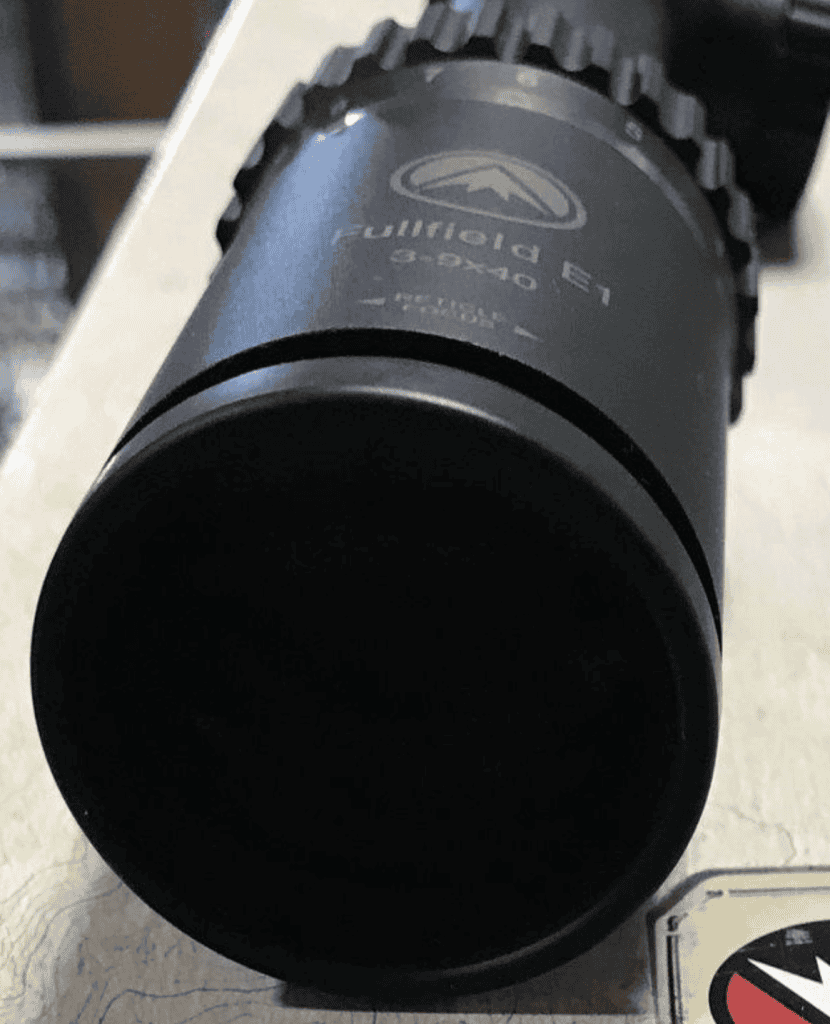
Ballistic Plex Reticle Misses the Point
The Ballistic Plex E1 reticle features multiple aiming points designed for bullet drop compensation. In theory, you range your target, select the appropriate hash mark, and hold accordingly. In practice, on a Marlin 336 shooting .30-30 Winchester at woods hunting distances, it’s unnecessary complexity.
Most of my shots with the 336 happen at distances where I’m holding dead-on with a 100-yard zero. The ballistic compensation marks become relevant only if you’re stretching past 150 yards, which isn’t what this rifle does well. I prefer the simple duplex reticles on the Leupold and Vortex—they get out of the way and let you focus on shot placement.
Where the Fullfield E1 Makes Sense
If you own multiple rifles and want one scope that can move between them, the 3-9x40mm configuration is versatile. I’ve run similar scopes on bolt-action .308s and .270s where the magnification range and 40mm objective make more sense. The glass quality is good—Burris builds solid optics—and the scope held zero reliably through testing.
But mounting a 3-9x40mm on a Marlin 336 feels like using the wrong tool for the job. The rifle was designed for close to medium range work in heavy cover, and this scope pushes it toward applications where bolt guns simply work better. At 13 ounces and 12.2 inches long, it’s heavier and longer than the compact Leupold while delivering a magnification range that doesn’t match the rifle’s strengths.
Build Quality and Budget Positioning
The Fullfield E1 sits in the budget tier alongside the Vortex Crossfire II, and the build reflects that positioning. The scope feels solid, turrets have decent clicks, and the multi-coated lenses provide adequate clarity. It’s not trying to compete with premium optics, and for what it costs, the quality is fair.
Burris backs it with their Forever Warranty, which is transferable and covers the scope regardless of what happens to it. That warranty support matters when you’re buying budget-tier glass, and Burris has a good reputation for standing behind their products.
Field Test Data
| Test Parameter | Result |
|---|---|
| 100-Yard Group (Best 3-Shot) | 2.4″ from bench rest |
| Close-Range Target Acquisition (30 Yards) | 1.2 seconds from low ready—slowest in test due to 3x minimum |
| Usable Magnification at 200 Yards | 9x provided clear view but doesn’t change cartridge limitations |
| Eye Relief Sensitivity Test | Required precise head position, minimal tolerance for variation |
| Zero Retention (70 Rounds) | Maintained zero throughout testing |
Tested on: Marlin 336 Classic | Federal Premium Power-Shok 150gr JSP
Pros and Cons
PROS
|
CONS
|
Performance Ratings
Learn more about how I test and rate scopes.
The Burris Fullfield E1 is a capable scope that’s simply mismatched to what the Marlin 336 does best. If you need one scope to move between a lever-action and a bolt gun, it’s worth considering. But if you want optics that enhance the 336’s strengths rather than work against them, look at the lower-magnification options in this test.
How I Actually Tested These Scopes
I mounted all four scopes on my Marlin 336 Classic in .30-30 Winchester—same rifle, same Weaver base, same medium-height ring class (1-inch rings for the Leupold/Vortex/Burris, 30mm rings for the Monstrum), same ammunition across every test session to keep variables consistent. Testing happened over three weeks in November, with temperatures ranging from the mid-30s on cold mornings to upper 50s on warmer afternoons. Most range work took place at my family’s property near Waco, Texas, where I have access to distances from 25 yards out to 200.
I shot approximately 320 rounds of Federal Premium Power-Shok 150-grain JSP ammunition through these scopes. That’s the load I trust in the .30-30—flat-nosed bullets designed for tubular magazines, consistent performance, and it’s what I actually hunt with. Each scope got zeroed at 100 yards, then tested at multiple distances including 50, 100, 150, and 200 yards from various positions—bench rest for accuracy testing, standing off sticks for field simulation, and some kneeling work to see how eye relief held up with less stable positions.
Two scopes I tested didn’t make this list: a Simmons 3-9x40mm that lost zero after about 50 rounds and showed significant point-of-impact shifts that I couldn’t track to anything I was doing wrong, and a CVLIFE 1-4x20mm that had terrible edge clarity—the image turned to mush outside the center third of the glass. Both were returned. I also evaluated a Barska 3-9x32mm that held zero but had glass quality so poor I couldn’t confidently identify vitals at 100 yards in late-afternoon light, which is a fundamental failure for hunting optics.
Beyond paper testing, I carried each mounted scope through actual hunting conditions—walking property lines checking feeders, glassing fields from a blind, and spending time in the thick oak and cedar motts where I hunt whitetail. That real-world carry showed which scopes stayed balanced on the rifle and which ones fought the 336’s natural handling.
Get more information on how I test optics here.
What Shooters Get Wrong About Marlin 336 Scopes
Thinking “Standard Hunting Scope” Means 3-9x40mm
Gun shops push 3-9x40mm scopes because they mount them on everything. But that 3x minimum cuts your field of view in half compared to a 1.5x scope. I’ve watched hunters struggle to find deer at 40 yards because they’re looking through a narrow tunnel. The 336 was designed for quick shots in heavy cover—that 3x minimum works against the rifle’s strengths. Start at 1.5x or 2x max, and you’ll maintain the fast target acquisition that makes lever guns effective in thick timber.
Ignoring Scope Weight on a Light Rifle
The 336 weighs around 7 pounds with most weight centered over the action. Add a 17-ounce scope and the front end gets noticeably heavier. After a few hours carrying it, you’ll feel the difference. Compact, lightweight optics maintain the rifle’s natural balance point—that’s not about saving ounces, it’s about preserving how the rifle handles when you need to make a quick shot.
Mounting Scopes So Low You Lose the Iron Sights
Some shooters mount scopes as low as possible, removing the rear sight completely. Then when the scope fogs up or you just want irons, you’ve got a problem. Medium-height rings often clear the rear sight on most 336 variants while maintaining comfortable eye alignment, but longer scopes or specific eye relief needs can still require removing the rear sight. If you want to keep irons as a backup, choose compact objectives and be prepared to fold the rear sight down—or remove it only when necessary to achieve proper eye relief.
Choosing Scopes Based on Maximum Magnification
Shooters see 9x and think “more is better” without asking if they need it. The .30-30 Winchester is a 150-yard cartridge. At that distance, 4x magnification is plenty for precise vital shots. What matters more is your low-end magnification—wide field of view, fast target acquisition, peripheral vision to track movement. That’s where 1.5x versus 3x becomes obvious in actual hunting conditions.
Your Questions Answered
Can I use Weaver-style rings or do I need Marlin-specific mounts?
The 336’s receiver uses the standard Weaver pattern, so any Weaver rings and bases work fine. I prefer one-piece bases for stability. Medium-height rings usually work best—they clear the rear sight and give good eye alignment.
Will a scout scope setup work on the Marlin 336?
You can do it, but it’s solving a problem that doesn’t exist on this rifle. The 336 already has side ejection that makes traditional mounting easy. Scout mounting that far forward costs you eye relief advantages. Stick with conventional mounting over the receiver.
Do I need to remove the rear sight to mount a scope?
Depends on scope size and ring height. Compact scopes like the Leupold 1.5-4x20mm often clear a folded rear sight with medium rings. Larger objectives might require removing it. Choose medium rings and smaller objectives if you want to keep irons as backup.
What’s the maximum effective range with a scope on the 336?
The scope doesn’t change .30-30 ballistics. With 150-grain factory loads, around 150 yards is your practical hunting limit for clean kills on deer. Past that, drop gets steep and energy falls off. A scope with 4-6x magnification is plenty—you don’t need 9x for a cartridge limited by its ballistics.
Which Scope for Your Shooting Style?
Traditional brush hunter in thick timber: The Leupold VX-Freedom 1.5-4x20mm is what you need. Most shots happen inside 75 yards where deer appear suddenly—you need wide field of view more than magnification. The 1.5x low end keeps you fast, the light weight won’t tire you out, and 4x handles occasional longer shots. This is what I’d mount on my own hunting 336.
Budget-conscious but want reliable glass: The Vortex Crossfire II 2-7x32mm delivers way more than expected for the price. The 2x low end isn’t quite as fast as the Leupold but close enough, and 7x gives you more reach. The unlimited VIP Warranty adds real value at this price point.
Hunt primarily at dawn and dusk: The Monstrum Banshee’s illuminated reticle gives you a legitimate advantage during those critical first and last minutes of shooting light. True 1x is fastest for close work. Just know you’re trading rifle balance for those features—the extra weight matters on a light lever gun.
Want one scope for multiple rifles: The Burris Fullfield E1 makes sense if versatility matters more than optimizing for the 336 specifically. The 3-9x40mm works adequately on everything from .243s to .30-06s—just not ideal for what the 336 does best.
Disclosure
I purchased all four scopes in this guide with my own money from regular retail sources—no manufacturer samples, no sponsored arrangements. When you click links on this site and make a purchase, I may earn an affiliate commission at no additional cost to you. These commissions help cover testing costs and keep the site running, but they don’t influence my recommendations. I only recommend scopes I’d actually mount on my own rifles, and I’m honest about the limitations I find during testing.
Final Thoughts
The Marlin 336 doesn’t need maximum magnification—it needs optics that preserve what makes it work. After testing these four scopes through actual hunting conditions, the Leupold VX-Freedom 1.5-4x20mm proved exactly what I expected: compact, lightweight glass matched to the rifle’s real-world role delivers better results than trying to turn a brush gun into a long-range platform.
The other scopes have their place. The Vortex Crossfire II offers impressive value on a budget, the Monstrum Banshee adds low-light capability, and the Burris Fullfield E1 works for multi-rifle use. But none match the 336 as naturally as the Leupold does.
I learned this years ago mounting too much scope on my first lever-action. Fighting front-heavy balance and narrow field of view taught me that matching optics to a rifle’s actual purpose matters more than chasing features. The 336 with properly chosen glass becomes exactly what it was designed to be—a fast-handling tool for woods hunting where shots happen quick and close. Mount the wrong glass and you’re working against the rifle.
If you are looking to shoot on shorter ranges, check my guide on shotgun scopes and air rifle scopes guide.
Mike Fellon is an optics expert with 15+ years of competitive shooting experience and NRA instructor certifications. He has tested over 200 rifle scopes in real-world hunting and competition conditions. Based in Dallas, Texas.

